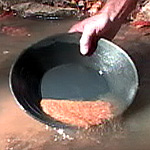2006年VOA标准英语-Modern-Day Prospectors on Quest for Gold(在线收听)
By June Soh
Washington, D.C.
24 November 2006
watch Gold Prospecting report
Gold has a glittering appeal that fascinates people generation after generation. While the famous gold rush in the middle of the 1800s, in the western U.S. state of California, was over long ago, modern-day prospectors on a quest for gold are drawn to the waters in the eastern state of Virginia. But this time, no one is really expecting to get rich. Amy Katz narrates the report.
---
 |
| Panning for gold in a stream in Virginia |
It is gold that lures Estep, who owns a construction company, to the creeks and rivers in Fauquier County, Virginia. "Every chance we get, but every weekend. As often as I can in between my work schedule," says Estep.
He says he could not believe his eyes when he found the glitter for the first time. "[I was] very excited and happy that, after all the hard work, hours of and some of the manual labor that you were doing in the creek, I was extremely happy to find it."
The eastern state of Virginia was one of the first gold-producing states in the U.S., according to the state's Division of Mineral Resources. Bob Sinclair is the curator of the Monroe Park Gold Mining Museum in Fauquier County. "Contrary to the popular belief that the first gold rush in the United States was to the state of California in 1849, the first true gold rush was in the 1790s here in the eastern part of the United States."
With the commercial mines now all closed, there is a new growing community of gold prospectors in the area.
Tom Sablon is the president of the Northern Virginia Gold Prospectors club. "The club originally started with about 12 people and it was called the Virginia Gold Prospectors Club. And four and a half years ago we changed the name to Northern Virginia Gold Prospectors. One time we had about 350 members," he added.
The museum's Bob Sinclair told us, "It is a total fascination that persons have an unending quest and unending search for places that might have gold. Of course, the ever-escalating value of gold is driving additional persons to this park as well."
William Walther has been prospecting for gold for two years now. He shows the fruits of his labor. "I feel good. I don't think gold ever not pleased the human race," says Walther.
But he offers a piece of advice. "A lot of hard working finding that. I will say, don't quit your day job, and don't think you are going to make a living finding gold."
Some gold prospectors use a metal sluice box, suction dredger, or motorized sluice/dredge machine to process more sand and mud, and filter out the gold.
But the most popular way is old-fashioned panning that allows heavier materials including gold to settle down to the bottom of the pan.
It took four years for Bill Curtis to make his glittering collection. He says it would be worth about $8,000 if made into jewelry. But he has no plans to sell.
"Oh, no. That's something I will never do. It is something that I found, I won't, I really don't want to sell it."
Like Curtis, most gold prospectors don't want to sell. But then why toil every weekend?
"It is just a fever. I know it is there. It is just laying out for me to pick it up,” says Curtis. “Once I (you) find, sometimes a fair amount of gold, then you get the fever also. Then you know exactly what I am talking about."
This was not a good day for Curtis. After putting in a good half-day's work, he didn't find much gold. Nevertheless, he says, he feels great. Because after all, what he really enjoys is getting outdoors and breathing fresh air.